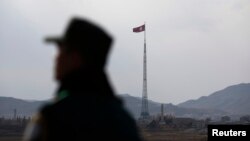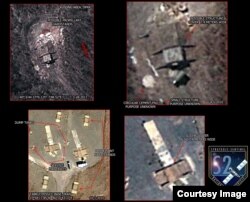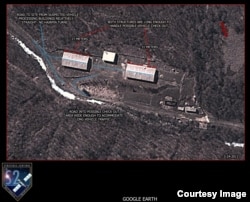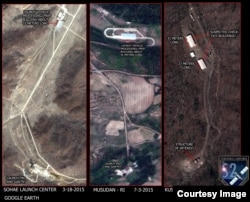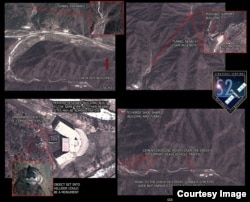New reviews of satellite images suggest North Korea may possess another missile launching site at a village once suspected of having nuclear facilities.
The images, analyzed by Strategic Sentinel, a firm that deals with geospatial image processing, intelligence analysis and geopolitical research, exposed a missile silo in mountainous Geumchang-ri, North Pyongan province, where the U.S. intelligence community said in the late 1990s there was a nuclear weapons site.
The silo, an underground chamber used for storing and firing missiles, seems analogous to the one at a missile base in Tabriz, Iran, with the same 7.4-meter-wide sliding cover and the same type of exhaust vents, the intelligence consultancy told VOA on Tuesday.
That U.S.-based group added that this rectangular-shaped structure appears large enough to house current North Korean missiles capable of carrying nuclear warheads that can strike neighboring countries, such as South Korea and Japan.
“If this Iranian site is housing missiles and the North Korean site that we have uncovered is the exact same dimension, then it’s quite possible that the site that we have uncovered is housing missiles as well,” said Ryan Barenklau, founder of Strategic Sentinel.
He also suggested a possible nuclear cooperation between the two countries.
Just north of the silo, three structures, which appear as check-out points and a below-ground access point, stood in a triangle formation, and a possible guard post also was within close proximity, the satellite images showed.
Barenklau said one thing to take note of is the great similarity between this clandestine facility and North Korea’s other established missile-launching sites in terms of the way structures are set up and the distance between check-out points and launch pads.
Unlike the conventional 55-meter-long launch vehicle processing buildings, the two check-out buildings at the suspected site, however, measure about 27 and 31 meters long, respectively, with a vacant lot in between them.
Asked about the difference in size of missile assembly buildings, Nathan Hunt, chief operations officer of Strategic Sentinel, said, “If this was some type of missile-related structure, (it) would not be for something large but for smaller missiles, possibly a Rodong or such.”
While other sites, such as the Sohae Satellite Launching Station and the Tonghae Satellite Launching ground, also known as Musudan-ri, accommodate “very large space launch [vehicles] or Taepodong-type missiles," he said.
Collected between 2010 and 2014, the satellite images also highlighted an unpaved, 6-meter-wide road, along which a number of cement crossings were installed.
Pointing out that construction of such infrastructure could cost several million dollars, the group insisted that the reclusive regime would only have built it “to support large vehicles to move heavy, military assets to the site.”
However, additional reviews of new satellite images need to be done in order to ascertain the exact purpose of the facility, Barenklau said.
The firm’s discovery of the suspected missile launching site came months after North Korea conducted two missile tests in October, which, according to the South Korean Joint Chief of Staff, were attempted near Panghyon Airport in Kusong City – located south of the suspected site. The exact location of the launch pad has yet to be discovered.
Despite global condemnation and increasing sanctions on North Korea, the reclusive regime remains steadfast in its determination to advance its nuclear and missile programs, conducting two nuclear tests and firing more than 20 ballistic missiles this year alone.
VOA Korean Service’s Jeeun Lee contributed to this report.




